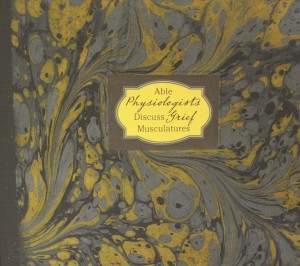Frances Hunter is a book designing force.
She’s tireless when it comes to traditional bookmaking methods, and her latest JackPine project demonstrates her willingness to take on old school art forms perfectly. Stitching a flat-backed hardcover chapbook with a cloth spine would be a mammoth project to take on solo, but Frances upped the ante by marbling her own paper for the cover boards and section dividers. The result is pretty mesmerizing, so it’s no surprise that her collaboration with poet Shane Neilson, Able Physiologists Discuss Grief Musculatures, sold out almost immediately after the launch.
So when I had to part ways with the last copy of what became known affectionately as “Able Fizz,” I naturally set out to learn how to marble paper myself. It’s spectacularly easy, but the materials you need (special acrylic paint, in particular) can be pricey. (Which seemed to me like a good enough reason to hold a free paper marbling program at the Saskatoon Public Library).
Here’s what I learned:
It’s a very old art form (the Persians had the best name for it: ebru or “could art”), but there are plenty of new ways to do it, including one sneaky method involving shaving cream.
- Dissolve some household alum in water to treat your paper. This will help the paint stick to the paper, and make your colours more vivid.-
- Make a solution (called a “size”) that you will put in a shallow tray. This can be a gelatin (carrageenan) or methyl-cellulose (which sounds scary, but is non-toxic).
- Add your paint to the solution, drop by drop, where it will hold the paint in suspension on the surface.
- Use a comb or stick to stir the colours gently. At this point, blotches can be made into more intricate colour patterns that might remind you of a peacock. If you’re lucky
- Lay a sheet of your alum-treated paper onto the surface of the water to absorb the colours.
- Rinse paper in a shallow pan of water and hang it to dry.
If you’re letting children experiment with the stuff, keep in mind that they are ENTHUSIASTIC paint supply killers. They’ve got that innate childhood passion for mixing colours together just to see what happens. Ironically, the colours don’t really mix so much as saturate the medium, so the majority of your paint will settle to the bottom and go to waste if you don’t keep a leash on their animal instincts.
With that said, adults and children alike can appreciate how wicked fun it is to marble. Some places to get started if you want to learn more are here and here, and of course, hit up Youtube for a visual demo.

